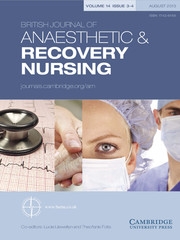No CrossRef data available.
Article contents
The Obesity Epidemic: What does it mean to the PeriAnesthesia Practitioner?
Published online by Cambridge University Press: 01 November 2008
Abstract
Alexander and Liston coined the term ‘Obesogenic society – where people are addicted to fast foods and supermarkets and a sedentary lifestyle promoted by television and cars’ [Alexander and Liston, 2006, p. 1167]. It is an undeniable fact that the United States has an overweight and obesity problem, the prevalence has doubled since 1960, the latest statistics from the Center for Disease Control and Prevention (CDC) report obesity (body mass index (BMI)⩾30) in adult men (33.3%) and adult women (35.3%) and more than 66% of adult Americans are considered overweight [CDC (Department of Health and Human Services), 2008]. Extreme obesity has increased from 0.8% to 4.9% [Bellar et al, 2008]. Visit the CDC website at http://www.cdc.gov/nccdphp/dnpa/obesity/trend/maps/index.htm for a very graphic slide show of the ‘fatting of America.’
The Weight Control Information Network classifies obesity as a chronic illness with an annual $117 billion cost (Weight-control Information Network (National Institute of Diabetes and Digestive and Kidney Diseases (NIDDK) of the National Institutes of Health (NIH)), 2007). In 2003, obesity was the second leading cause of preventable death in the United States [Garza, 2003]; it is now on the way to surpassing smoking [Abir and Bell, 2004]. But it is not just a problem in the United States; it is becoming a worldwide problem. What does this obesity epidemic mean to the PeriAnesthesia practitioner?
- Type
- Original Article
- Information
- British Journal of Anaesthetic & Recovery Nursing , Volume 9 , Issue 4 , November 2008 , pp. 84 - 90
- Copyright
- Copyright © British Association of Anaesthetic and Recovery Nursing 2008


